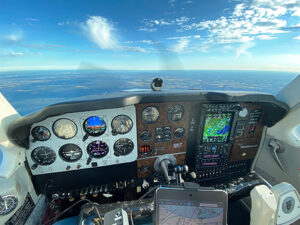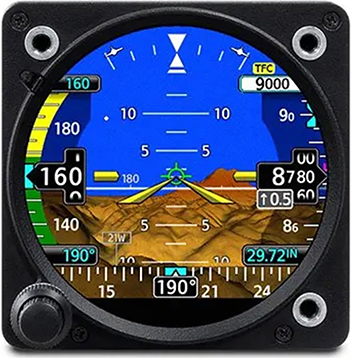by Michael J. “Mick” Kaufman
© Copyright 2023. All rights reserved!
Published in Midwest Flyer Magazine February/March 2023 Digital Issue

We have become so dependent on autopilots in the aircraft we fly, it has become apparent that we have lost many of the skills to hand-fly our aircraft.
Having done a great number of instrument ratings from start to finish in my over 50 years as a flight instructor, I still teach and put a lot of emphasis on the flying basics. In my 10-day instrument training courses, the first four to five days of flying involves developing a good instrument scan.
The trend in instrument training these days is focused on autopilots and “button-ology,” when it should start with flying the airplane and developing a good instrument scan. I also see pilots focusing on going to full glass panels versa the six-pack of instruments. By going this route, it is more difficult to develop good hand-flown instrument skills.
As the revolution in aviation training changed to using numeric tapes, rather than conventional instrument pointers, it is apparent and without a doubt that gauges with pointers are far easier to use when hand-flying an aircraft.
Many years ago, when the concept of altitude and speed tapes were thought of for the airlines, a study was done by McDonnell Douglas. Remember the DC-9/DC-10 aircraft of decades ago?
During that study involving a longtime friend of mine, who was a test pilot for McDonnell Douglas and an airline liaison manufacturer, the study showed that speed and altitude tapes were more difficult to hand-fly than gauges with pointers.
So, why do we see these high-tech tape instruments appearing on so many of our new generation avionics? It is because we have evolved into an autopilot flying aircraft society.
Watching inside cameras in a NASCAR race on TV, we do not see digital speedometers, oil pressure gauges, tachometers, or temperature gauges, do we? In fact, in some cases, the gauge has been rotated in their bezels, so the pointer is pointing straight up when everything is in the desired operating parameters of the car.
Having just completed an instrument rating in a Bonanza with an upgraded Garmin panel, which had two Garmin GTN-650s driving a G-500 TXI, I discovered that my instrument student was struggling with the altitude and airspeed tapes.
Unknown to most pilots, you can configure the G-500 TXI to round instruments with pointers replacing the tapes. This can be done in the setup of the display. So that’s what we did.
Wow, what a difference this made to the student while learning to hand-fly the aircraft during his initial instrument training. Altitude control went from plus or minus 300 feet to plus or minus 50 feet instantly. There is truth in that study showing that the tapes are more difficult to fly than the pointers of the round gages.
Back in the days of conventional six-pack instruments, I taught scanning patterns to help develop instrument skills. This is still important for hand-flying the airplane. I would tell students as time passes and with practice, that eventually scanning individual instruments will someday become so efficient you will feel that you are scanning the whole instrument panel at the same time.
In recent years with so much information available in many places, pilots have become saturated with so much information that they do not know what to scan. I have written about this phenomenon many times in my column.

I often ask pilots during training or recurrent training what they are looking for as they continuously change screens on their displays. They don’t have an answer. If we fly instruments by the numbers when we are inside the final approach fix, our scan can be reduced to just a few instruments. If you are flying a flight director with a Garmin GI-275, I should be able to cover up everything else on the panel and watch you make a perfect hand-flown precision approach.
What information do we need once we have passed the final approach fix?
First, follow the flight director using our controls and ask how low we can go before deciding to land or go missed. Displaying this on the attitude indicator of a Garmin GI-275 in-flight director mode works great, and you can have an altitude tape displayed to show when to go missed. You can even program the decision altitude in the display for an alert should your memory be questionable.
Let’s get back to basics. Hand-flying an instrument approach can be so easy, and many pilots make it so difficult. It takes training, practice, and recurrent training to perfect some of these flight skills.
I have become a fan of the Garmin GI-275 and would consider having two of these units in my own airplane. It is a good consideration for a pilot if he is looking at a panel upgrade.
You will have electronic instruments with a bright readable display and backup AHARs should two electrons get crossed with each other. Hand-flying the six pack is easier than tapes, and with a recent bulletin on some failure issues with the Garmin GFC-500 autopilot, having good hand-flying skills is even more important. I will be writing more in my column in Midwest Flyer Magazine on the Garmin GI-275 and G-5 instruments in future issues. Until then, fly safe!
EDITOR’S NOTE: Michael J. “Mick” Kaufman is a Certified Instrument Flight Instructor (CFII) and the program manager of flight operations with the “Bonanza/Baron Pilot Training” organization. He conducts pilot clinics and specialized instruction throughout the U.S. in many makes and models of aircraft, which are equipped with a variety of avionics. Mick is based in Richland Center (93C) and Eagle River, Wisconsin (KEGV). He was named “FAA’s Safety Team Representative of the Year” for Wisconsin in 2008. Readers are encouraged to email questions to captmick@me.com, or call
817-988-0174.
DISCLAIMER: The information contained in this column is the expressed opinion of the author only, and readers are advised to seek the advice of their personal flight instructor and others, and refer to the Federal Aviation Regulations, FAA Aeronautical Information Manual, and instructional materials before attempting any procedures discussed herein.